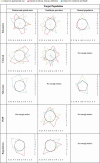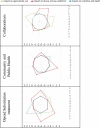A systematic review of strategies to improve appropriate use of opioids and to reduce opioid use disorder and deaths from prescription opioids
- PMID: 35005381
- PMCID: PMC8730669
- DOI: 10.1080/24740527.2018.1479842
A systematic review of strategies to improve appropriate use of opioids and to reduce opioid use disorder and deaths from prescription opioids
Abstract
Background: Abuse of prescription opioids is a serious problem in North America.
Aims: The aim of this study was to conduct a systematic review of peer-reviewed and grey literature to examine existing strategies aimed at improving the appropriate use of prescription opioids and/or reducing the misuse, abuse, and diversion of these drugs.
Methods: The following electronic databases were searched to September 2015 without language restrictions: MEDLINE, EMBASE, PsycINFO, and CINAHL; the grey literature was searched to May 2014. Reference lists of retrieved papers were also searched. Studies were eligible if a strategy was implemented and its impact on at least one of the primary outcomes of interest (appropriate prescription opioid use; misuse, abuse, opioid use disorder, diversion; overdose) was measured. Standardized, prepiloted forms were used for relevance screening, quality appraisal, and data extraction.
Results: A total of 65 studies that assessed 66 distinct strategies were identified. Due to the heterogeneity of the strategies, a qualitative synthesis was conducted. Many studies combined more than one type of strategy and measured various types of outcomes. The strategies with most promising results involved education, clinical practices, collaborations, prescription monitoring programs, public campaigns, opioid substitution programs, and naloxone distribution. We also found strategies that had some unintended consequences after implementation.
Conclusions: Our review identified successful strategies that have been implemented and evaluated in various jurisdictions. There is a need to replicate and disseminate these strategies where the problem of prescription opioid misuse and abuse has taken a toll on society.
Contexte: L’abus d’opïodes sur ordonnance est un problème grave en Amérique du Nord.But: Effectuer une revue systématique de la littérature examinée par des pairs eet de la littérature grise afin d’étudier les stratégies existantes pour améliorer l’usage approprié des opioïdes sur ordonnance ou réduire la mauvaise utilisation, l’abus ou le détournement de ces médicaments.Méthodes: Des recherches ont été effectuées sans aucune restriction de langue dans les bases de données électroniques suivantes : MEDLINE, EMBASE, PsycINFO et CINAHL jusqu’en septembre 2015 et dans la littérature grise jusqu’en mai 2014. Des recherches ont aussi été effectuées dans les listes de références des articles retenus. Les études étaient admissibles si une stratégie avait été mise en oeuvre et que son effet sur au moins un des principaux résultats étudiés (usage approprié des opioïdes sur ordonnance; mauvaise utilisation, abus, trouble de consommation ou détournement des opioïdes; surdose) avait été mesuré. Des formulaires normalisés et préalablement mis à l’essai ont été utilisés pour déterminer la pertinence et évaluer la qualité des études, et en extraire les données.Résultats: Au total, 65 études évaluant 66 stratégies distinctes ont été répertoriées. En raison de l’hétérogénéité des stratégies, une synthèse qualitative a été effectuée. De nombreuses études combinaient plus d’un type de stratégie et mesuraient divers types de résultats. Les stratégies dont les résultats étaient les plus prometteurs portaient sur l’éducation, les pratiques cliniques, les collaborations, les programmes de surveillance des ordonnances, les campagnes publiques, les programmes de substitution des opioïdes et la distribution de naloxone. Nous avons également trouvé des stratégies qui avaient eu des conséquences imprévues après leur mise en oeuvre.Conclusions: Notre revue a recensé des stratégies fructueuses mises en oeuvre et évaluées dans diverses juridictions. Ces stratégies doivent être reproduites et diffusées là où le problème de la mauvaise utilisation et de l’abus d’opioïdes sur ordonnance a eu un effet néfaste sur la société.
Keywords: opioids: strategies: policies; practices; programs; systematic review.
Published with license by Taylor & Francis Group, LLC.
Figures
References
-
- Public Health Agency of Canada . Statement from the co-chairs of the federal, provincial and territorial special advisory committee on the epidemic of opioid overdoses; 2017 [accessed 2017 Nov 27]. https://www.canada.ca/en/publichealth/news/2017/09/statement_from_theco-....
-
- Public Health Agency of Canada . Statement from the co-chairs of special advisory committee on the epidemic of opioid overdoses on updates to opioid-related mortality data; 2017 Dec 18 [accessed 2017 Dec 30]. http://www.newswire.ca/news-releases/statement-from-the-co-chairs-of-spe....
-
- Canadian Institute for Health Information . Pan-Canadian trends in the prescribing of opioids, 2012 to 2016. 2017 [accessed 2017 Dec 26]. https://www.cihi.ca/sites/default/files/document/pan-canadian-trends-opi....
Publication types
LinkOut - more resources
Full Text Sources
Other Literature Sources






